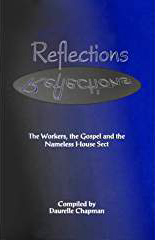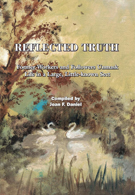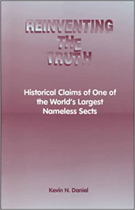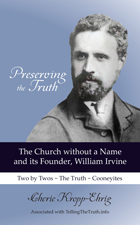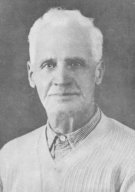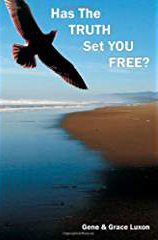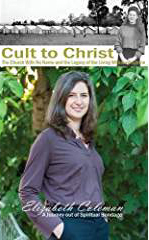Who Started the 2x2 Ministry and Church and When?
This summary concerns the historical events that occurred when the Sect began in Ireland--it is not about the spiritual beginning of the 2x2 Sect. There are sufficient documented facts available to formulate a good idea of what physically took place in the early years of the 2x2 Sect between 1897 and 1903.
Most groups start with an idea (with the 2x2 Sect, it was "Faith Lines") that they develop over time and put into practice. It then evolves, diminishes, or disappears. The 2x2 Sect has endured for over a century and has a lengthy history. To properly understand the formation and history of the 2x2 Sect, its is necessary to analyze its development progressively and intelligently.
What Event Was the Starting Point? There are ten possible answers. The Sect did not start all at one time or take form overnight. It took place in stages. As Edward Cooney expressed it, "we groped our way." First, the ministry came together, and a few years later, it progressed to baptism and fellowship meetings with communion were added.
The starting event was William Irvine's first highly successful revival mission at Nenagh, Ireland in 1897; Some believe the group coalesced into a loose-knit body at the St. Stephen's Meeting in Belfast, Ireland on December 26, 1899. The movement further evolved in 1902 with the first Sunday fellowship meetings with communion established in homes and baptisms by immersion instituted. In 1903 at Rathmolyon, it evolved another step with Irvine uniting and organizing the Workers into one body. The Workers went worldwide soon after. These major developments took place over about six years.
Below are ten possible answers followed by supporting details.
1. Was it the first two revival missions at Nenagh and Rathmolyon, Ireland where over 70 people were converted by William Irvine? In that case, the beginning was 1897.
2. Was it when William Irvine left Faith Mission? Then it was in 1897, 1898, 1899 or 1901.
3. Was it after the Bicycle Trip to Scotland at the all-day meeting December 26 at Nenagh? Then it was 1899.
4. Was it when the first convention was held at Rathmolyon? Then it was 1899.
5. Was it when John Long began preaching independently on Faith Lines? Then it was 1899.
6. Was it when Edward Cooney went out preaching on Faith Lines? Then it was 1901.
7. Was it when Todd's Mission disbanded? Then it was 1901.
8. Was it when the first Sunday morning fellowship meetings and baptisms began? Then it was 1902-03.
9. Was it when Irvine held the consolidation convention at Rathmolyon? Then it was 1903.
10. Was it around the turn of the twentieth century? Then it was from 1897 to 1903.
Now, let's explore the details.
1. Was it the first two revival missions at Nenagh and Rathmolyon, Ireland, where over 70 people were converted by William Irvine? If so, it was 1897.
NOTE : The 1897 Nenagh mission by William Irvine turned out to be a remarkable revival. According to John Long and others, Nenagh was where the movement started. Nenagh is considered to be Irvine's first independent mission, beginning in August and continuing through the end of 1897 in various locations in Southern Ireland (Long Aug. 1897, TTT ). In the Nenagh and Rathmolyon missions nearly all the converts (about 70) volunteered to go preach on Faith Lines. They formed the nucleus of the first group of Workers.
1897, August - William Irvine: "In November 1896, I was sent to the West of Ireland...After 6 or 7 months there, I got to where the Carrolls were in Nenagh; and there began the Work that has spread so far" ( Oct. 13, 1920 to Dunbars).
1897, August - John Long: "I used influence to get him openings which resulted in his holding a mission in the Methodist Church. Nenagh, County Tipperary, where a revival began in August 1897. That revival was the origin of the Go-Preacher fellowship (Roberts 1990, 12-13 ).
1897, June - John Long: "Now I come to the saddest events and most painful, trying and unexpected that I met with during my life's experience; namely having to leave the Go-Preacher fellowship; which God used me so much in, from its beginning , ten years ago [1897]" ( June 1907, TTT ).
1897 - John Long: "Mr. John Long has written us that he was the man who obtained for William Irvine 'the first opening for a mission in Nenagh, August 1897'...He declares that the movement dates from 1897' " (W. C. Irvine 1980, 73 ).
1897, August - John Long: "William Irvine and Fred Tapp left also and went to Spanish Point, and from there to Nenagh where the revival began...The Protestant School Mistress, Sister Oakley, was the first to get saved; altogether upwards of 30 persons of position and note got converted; most of them afterwards gave up all that they had to follow Jesus ( Aug. 1897 , TTT ).
1897, September - John Long: "At the mission held in Nenagh, a young man named Jack Carroll, also his sister May Carroll, got converted; they had a brother, Bill Carroll, who was a steward at Captain Fowlers, Rathmolyon, Co. Meath. Through their instrumentality they got the use of the schoolhouse in Rathmolyon for a mission for William Irvine where 40 persons got converted; most of them afterwards gave up their situations to go fully on the Lord's work" ( Sept. 1897 , TTT ).
1897 - Garrett Hughes: "Ninety years ago [1897], a letter came from Ireland. We heard about those with no home, no name, etc. Forty people made their choice. 16 went out in the Work--that was the beginning...There is not a country not open to the gospel now. It is the most marvelous thing ever to happen" (Oct. 6, 1987* Funeral Notes for Erling Omdal, Eagle Bend, Minnesota).
"Every country there (South America) is doing real well for the gospel now and it's surely a Way of what is going around the world over now in our day. It surely speaks of what began 90 years ago and has gone the world around." [1988 minus 90 years = 1898 was "what began 90 years ago"] (Aug. 1, 1988, to Julie Olson, Cando, North Dakota, TTT Photo Gallery )
1897 - Edward Cooney: In a 1913 case styled Edward Cooney v. The People Ltd. in London, Justice Darling asked Cooney if he was the founder of this sect. Under oath, Cooney replied "No, William Irvine was the first , about 16 years ago" [1897] ( Impartial Reporter Dec. 18, 1913 , TTT ).
1954 - Peter Comrie, brother-in-law of William Irvine: "It was definitely William Irvine who started this movement. Between he and Edward Cooney, they did everything. If John Hardie has misled you that this belief is from the beginning, that is definitely a lie. " (Parker 1982, 96).
NOTE: 1897 is the starting date used the most in the historical documents. It was used by: William Irvine, John Long, Edward Cooney, Goodhand Pattison, Alfred Trotter, Wilson McClung, Jack Jackson, Garrett Hughes, etc.
2. Was it when William Irvine left Faith Mission? If so, then it was 1897, 1898, 1899, or 1901.
NOTE: The exact year Irvine left the Faith Mission has not been established. The last year or two with the Faith Mission, Irvine was " going rogue," operating autonomously and not following their expected script. While still associated with the Faith Mission, he was simultaneously preaching on independent lines.
1897, September - William Irvine: "I was put out of Faith Mission in September 1897 " ( Dec. 4, 1921 , to Kerrs, TTT ).
1898-1899 - William Irvine: " In September 1898 , I was put out of the Faith Mission for not being willing to conform to all their piccadilly discipline, etc." ( Oct. 13, 1920 , to Dunbars).
1899-1899 - Wilson McClung: " Our mission was started by William Irwin [Irvine], a Scotchman, seven or eight years ago [1898-99]. Others followed him." ( Impartial Reporter June 21, 1906, 3, TTT ). Wilson McClung was Overseer of New Zealand for many years.
1901 - Doug Parker: "In 1901, Irvine resigned officially from the Faith Mission. George Walker and Matthew Wilson witnessed his formal resignation" ( Parker 1982, 6). NOTE: The TTT Editor was unable to confirm that this resignation took place as described.
1900, December - John Long: "About that time William Irvine left the Faith Mission. All who knew the man was acquainted with the fact that he did not covet or desire to start a new sect or mission...circumstances and events rendered it necessary. Some Workers who gave up their situations to go fully in the Lord's work were not accepted by the Faith Mission; others did not feel led to join it; and others believed in being more like the pattern as seen in Jesus...Most of these Workers were either young converts or disciples of William Irvine; and it became impossible for him to be true to the rules of the Faith Mission and to them; so he resigned the one and entered enthusiastically into the other" ( Dec. 1900 , TTT ).
1901 - John G. Eberstein, President of the Faith Mission, Edinburgh: "The William Irvine to whom your correspondent refers, and who was associated with Edward Cooney in the beginning of this movement, was a worker in the Faith Mission from 1895 to 1901. In that year, he withdrew from the Mission, and the new movement came into existence " (Eberstein 1964, TTT* ).
1901 - Bright Words , the monthly Faith Mission magazine, shows William Irvine as a Faith Mission Pilgrim through December 1900. Beginning in January 1901, they dropped his name from their Workers List. Their "Official List of Workers" gave the reason for his departure as: "founded Cooneyites in S. Ireland."
3. Was it after the Bicycle Trip to Scotland at the all-day meeting on December 26 at Nenagh? If so, then it was 1899.
1899 - Dr. Cornelius Jaenen: "In 1899 William Irvine, who had not yet been disaffiliated by the Faith Mission, proposed a bicycle tour of Scottish towns to a number of these independent evangelists. This was followed by an all-day meeting on the Feast of St. Stephen at Nenagh, which is sometimes cited as the moment of consolidation of the various contributing elements" ( Jaenen 2003, 524 ). NOTE: The Feast of St. Stephen or St. Stephen's Day is a Christian Saint's day celebrated on December 26 in the Western Church.
4. Was it when the first convention was held at Rathmolyon? If so, then it was 1899. NOTE: Subsequent conventions were also held there in 1900, 1901 and 1903.
1899 - William Irvine: "Was put out of Faith Mission and had first convention in Ireland 1899" (Irvine Oct. 13, 1920 , to Dunbars, TTT ).
1899 - William Cleland: "It might be a good question to ask those who say they are from the beginning, " Who was ahead of William Irvine ?" William Irvine was entirely responsible for the creation of this movement...His ideas of preaching were entirely on his ideas of Matthew ten...It went back to exactly 1899 when the first Workers gathered around Bill Irvine" ( Parker 1982, 96 ). NOTE: William Cleland was a brother to two of William Irvine's brothers-in-law.
5. Was it when John Long began preaching independently on Faith Lines? If so, then it was 1899. ( John Long resigned from his position as Methodist Colporteur in November, 1898.)
1899, January 1 - John Long: "On the first of January 1899, I started on the new lines of faith in God" ( Jan. 1899 , TTT ).
6. Was it in 1901 with Edward Cooney? No, for he wrote: "the man who finally moved me to go to preach was William Irvine" (Roberts 1990, 18). It was not when Edward Cooney went out preaching on Faith Lines in 1901 in Irvine's existing movement.
1901 - Edward Cooney: " 'Three years ago,' [1901[ said Cooney, 'the Lord said to me, 'Go, Edward Cooney, without scrip, and go into all nations, baptising them in the name of the father, Son, and Holy Ghost, and teach them to observe, 'all things whatsoever I have commanded you.' Then he gave me His promise, 'Lo, I am with you until the end of the world,' and he has kept it' " ( June 9, 1904, TTT ).
1906 - John Coles: "Here...are Irwin's [William Irvine's] own words spoken, with Cooney, in this very room. 'When,' said Irwin, 'I came across Cooney first he was a professed Christian man, and said he would work in business with all the zeal that he could command, and give the money that he could earn to help to carry on the Work.' "Irwin [Irvine] replied, 'I don't want your money. I want you.' And from that time, Cooney felt, 'Well, here's a man of God. In that conviction, continued Mr. Coles, Cooney gave up his business, fell out with his family, and began preaching" (Morning Leader, June 15, 1906, TTT ).
1914 - Edward Cooney, while under oath in a 1913 court case, he unequivocally stated he was not the founder of the Sect to Justice Darling: "William Irvine was the first, about 16 years ago [1897]. I cast in my lot with him as a fellow-preacher...others have nicknamed us 'The Cooneyites.' " (Impartial Reporter Dec. 18, 1913, 3, TTT ).
1917 - Edward Cooney, while under oath in a 1917 court case for John Baillie: " Mr Edward Cooney said he and three others* founded this church about 1900. In the United Kingdom were about 5,000 adherents and 70 ministers. He and Mr Gill were the overseers in this country. They took the New Testament as their guide." (March 30, 1917 South Western Star) *Speculating on identities of 3 others: Wm Irvine, Willie Gill and ?George Walker? Cooney joined in 1901.
1954 - Peter Comrie, brother-in-law of William Irvine: "It was definitely William Irvine who started this movement. Between he and Edward Cooney, they did everything."
7. Was it when Todd's Mission disbanded? If so, then it was 1901-03.
NOTE: William Irvine joined the Faith Mission 2-1/2 years before the Todds departed from the Faith Mission in November 15, 1897. They were acquainted and would have been together at least once a year for the Faith Mission week-long annual convention, if not more.
1901 - Goodhand Pattison: "Just at that time a Mr. and Mrs. Todd, who had been Faith Mission pilgrims, had started a similar line of things to Mr. Govan's...Anyhow, the connection didn't last very long as I believe the Workers jointly and individually felt Mr. Todd was not the man to superintend and direct such an important movement, and probably pressed Mr. Irvine himself into acceptance of responsibility...and 'Todd's Mission,' as it was then called, shortly became a thing of the past...And the Workers now in fellowship with William Irvine went on and increased in numbers...and in respect for their chief's leadership , possibly more so than was good for him or them " (1935, Workers, TTT ).
1901, September - J. G. Govan, founder of Faith Mission: "Mr. Todd is now appointed to the home secretaryship of the South American Evangelical Mission, with offices in Liverpool, and at the suggestion of himself, and his Workers , we [Faith Mission] have agreed to take over the superintendence of their missions" ( Bright Words May 1903 , TTT ).
8. Was it when the first Sunday morning fellowship meetings and baptisms began? If so, then it was 1902-03. NOTE: The date and location of the very first fellowship meeting not known for certain. It is common knowledge that the first in Dublin, Ireland, took place over Weir's Hardware Store at Twenty-one Baggot Street, in the home of William C. Weir and family. This may have been the first meeting ever held in Dublin or the first meeting ever held in all of Ireland. The Crocknacrieve gate lodge is the other location given for the first fellowship meeting.
1902 or 1903 - Goodhand Pattison: "Not long after my arrival (at Portadown convention) , perhaps the next day, Messrs. Irvine and Cooney together spoke to me on the subject of baptism, as at that convention for the first time to my knowledge, they started to baptise...I may here say in passing that the subject of baptism before this time formed no part of William Irvine's teachings...also in the matter of forming churches, both of which then were a good bit of a surprise to me...I then thought, just another attempt at forming a 'new party'" (1935, conventions, TTT ) .
9. Was it when Irvine held the consolidation convention at Rathmolyon? If so, then it was 1903. The 1903 convention was the third one held at Rathmolyon.
1903, July - John Long: "After that, we went to a convention in Rathmolyon. From that time, all the Workers began to baptize, and separate their converts; form them into assemblies to meet together on the first day of the week for fellowship, breaking of bread and prayers. Acts 2:42. Also, they appointed Bishops or elders over them. William Irvine emphasized separation, but not exclusiveness" ( July 1903 , TTT ).
1903 - George Beattie: "seventy of Irvine's converts met at William Gill's farm at Rathmolyon late in 1903 for a convention that lasted three weeks. They passed the severe test of entry to the new fellowship by giving over all to the common purse, and by casting off allegiance to their former ways of life...At that important convention he laid down the values and standards that were to be kept by his selected preachers, and a strict form of asceticism was made the rule of life...Irvine's followers were willing to accept his strict code of discipleship and at the close of the convention the men and women took a vow of poverty, chastity and obedience" (Parker 1982 , 20 Fn. 2 ).
1903 - William Cleland : "Regarding the meeting in Rathmolyon when the Vow of Celibacy was taken by the Brother Workers; I was there at the meeting and promised like the others to observe it. This happened in 1903. It then became the recognized thing for all Workers, and any one failing to observe it was just not right and looked upon gravely with suspicion" (Parker 1982, 20, Fn. 3 ).
10. Was it around the turn of the twentieth century? If so, then it was between 1897 and 1903 .
NOTE: This six-year range covers three years in the nineteenth century and three years in the twentieth century. Although somewhat ambiguous, it is accurate to state that the 2x2 Sect started "at the turn of the twentieth century."
George Walker's Statement to the U.S. Selective Service. "during the closing years of the last century and the first years of this century a number of people in the British Isles and in America were exercised in heart and mind, through their study of the Scriptures, in regard to the methods of preaching and worship in the several churches of which they were then members" ( 1942 Statement, TTT, RIS) .
Dr. Cornelius Jaenen: "By the last decade of the nineteenth century, a number of religious activities in the British Isles gave rise to a movement which first manifested itself at Nenagh, in county Tipperary, and soon spread throughout Ireland, and eventually throughout the world by the end of the twentieth century. This nameless spiritual fellowship, sometimes condescendingly referred to as the Two-by-Twos, espousing the ideals of apostolic preaching and evangelical poverty, participatory worship in the homes of the laity, and observance of the ordinances of immersion baptism and frequent communion" (Jaenen 2003, 518).
William Lewis told a reporter "Since early Workers followed a Scottish preacher in Ireland before the turn of the twentieth century, they have spent their lives traveling from home to home with little more than their clothes" (Franklin Nov. 2, 1896*). NOTE: William Lewis, deceased, was the Minnesota and Texas Overseer for a time.
In 1897, John Long recorded details about William Irvine's first two revival missions held that year at Nenagh and Rathmolyon, Ireland, after which about 70 converts went out preaching forming the core of Irvine's first group of Workers. This is a good basis for using 1897 as their start date.
In 1902-03, the Workers began moving their converts out of the churches they had been attending and started forming churches in homes where they assembled on Sundays and took communion. They also began baptizing new converts and to rebaptize Christians. The movement separated from other Christians bodies and was divided into two tiers, Workers and Friends.
In 1903 Irvine united and organized the rapidly growing group of Workers and the Workers pledged their allegiance to the basic tenets of belief and practices at a three-week convention held in Rathmolyon. By 1903, they were an organized Sect. The inaugural convention was held in 1903 when they consolidated into a cohesive sect, and it was also the year the first three Workers ventured to America.
NOTE: 1897 is the date used the most in historical documents. It is documented in newspapers and early writings by these early Workers: William Irvine, John Long, Ed Cooney, Goodhand Pattison, Wilson McClung and Jack Jackson. The TTT Editor uses 1897 for the starting date because John Long, who was present at the beginning, and the majority of other historical accounts do so.
When was the actual 2x2 ministry started or founded?
Short answer: It was started or founded in Ireland around the turn of the twentieth century by a Scotsman named William Irvine.
Who Was the Founder of the 2x2 Ministry and Church ?
Seven possibilities have been suggested:
1. It was started by "a number of people"?
2. It was started by John Long
3. It was started by Robert Todd?
4. It was started by Edward Cooney?
5. It was started by George Walker?
6. It was started by Jack Carroll?
7. It was started by William Irvine?
Definition of Founder . Those who refer to William Irvine as the "founder" of the 2x2 ministry and church use the word in the context of an "originator." They are not saying that Irvine originated the idea of the apostles traveling through Palestine in pairs; or the idea of Christians meeting for fellowship or worship in homes; or any other true Christian doctrine.
Rather, they are saying that William Irvine founded or pulled together the Fellowship of the Friends and Workers as a distinct group or body of people. Irvine also founded or originated the idea that true ministers should imitate some (but not all) the instructions Jesus gave the Apostles on their limited mission to Israel in Matthew 10. The type church Irvine founded is known as a "restoration movement." His goal was to restore the methods of the primitive New Testament church, which he called an "experiment."
1. Was it started by "a number of people"?
George Walker wrote: "We take this opportunity to state that during the closing years of the last century and the first years of this century a number of people in the British Isles and in America were exercised in heart and mind, through their study of the Scriptures, in regard to the methods of preaching and worship in the several churches of which they were then members. They were deeply concerned about spiritual things, and became fully convinced that there should be a return to the methods and purposes taught and carried out by Christ and His first disciples. This conviction led to frequent earnest conversations and studies on the subject, which in turn led to religious meetings, and in due time a number of these people went forth to devote their lives to the preaching of the gospel according to the teaching and example of Christ as given in the New Testament (1942 Statement, TTT , RIS).
2. W as it started by John Long? (1899)
In August 1897, John Long arranged for a place for Irvine to hold a mission at Nenagh, Ireland where the revival began. John did not claim to be more than a fellow-helper to William Irvine. A little over a year and a half later, on January 1, 1899, John began independently preaching on Faith Lines. He wrote: "Now I come to the saddest events and most painful, trying and unexpected that I met with during my life's experience; namely having to leave the Go-Preacher fellowship; which God used me so much in, from its beginning, ten years ago...the wrong done to me at that time severed me from some of my near relatives; and robbed me of my privilege, namely the right of fellowship in the mission I helped to start " ( June 1907 , TTT ). John Long was not the founder.
3. Was it started by Robert Todd? (1897-1901)
In November 1896, Robert R. Todd and his wife Jeanie left the Faith Mission to start an independent mission in Ireland, commonly called "Todd's Mission." It was disbanded in 1901 when Todd took a job in Liverpool and took a position as a Congregational minister. Afterwards, some of Todd's Workers joined Irvine's mission, while others joined the Faith Mission. See also chapter 10 . Todd was not the founder.
4. Was it started by Edward Cooney? (1901)
Cooney wrote: "the man who finally moved me to go to preach was William Irvine " (Roberts 1990, 18 ). To the question asked by Justice Darling: "Were you the founder of this sect?" Edward Cooney stated while under oath: "No, William Irvine was the first , about 16 years [1897] ago . I cast in my lot with him as a fellow-preacher" (Impartial Reporter Dec. 18, 1913 , TTT ). William Irvine was already preaching before Cooney joined his group in 1901. Cooney was not the founder.
5. Was it started by George Walker? (1899)
George Walker was twenty-one in March 1898, when he first heard William Irvine preach. On April 11, 1898, he made his decision to join Irvine, reportedly, on a railway station platform in Dublin, Ireland. He became an independent full-time Worker on Faith Lines sometime in 1899. George Walker was not the founder.
6. Was it started by Jack Carroll?
William Irvine went to Nenagh where the revival began where Jack and May Carroll were converted. Ja ck Carroll is shown as entering the Work in 1904 on the 1905 Workers List. Jack Carroll was not the founder.
7. Was it started by William Irvine? (1897)
Irvine wrote : "I am the one God used altogether--not 'most.' No William--No Testimony " ( March 2, 1923 , to Ed Cooney, TTT ). NOTE: Irvine called the 2x2 Sect t he "Testimony." He wrote:
"I am satisfied that The Testimony was the result of my anointing without any help from others , and in spite of all my so called helpers...I don't say this out of vanity or vain glory or in order to despise any who had truly the nature and anointing of God, but I say if I had not been, I don't see anybody who could or would have done as I did" ( June 24, 1921 , to Charles and wife, TTT ).
"I can look back with Joy on it all and say that God and I were the only shapers of the whole Way, Truth and Life which so many are so fond to claim as their own. The work in U.S.A. and Canada was all built on the very little friendships which I had made. Same in South Africa, Australia, New Zealand...It was all God and I from first to last--and all we have seen since has only been like most others going because they were provided for, and a soft imitation of the Early days. I was as the mainspring and the binder together, which was the real strength of The Testimony. And when I had finished the House, it was to find myself out and with God; and the House in possession of thieves and robbers--as it was in Jesus' day" ( Dec. 4, 1922 , to Dunbars, TTT ).
Summary. William Irvine was "the first," the founder, and leader, according to early Workers William Irvine, John Long, Ed Cooney, Wilson McClung, Jack Jackson, and the historical accounts of Goodhand Pattison, Alfred Trotter, and John Long.
The year 1897 is the date used in most historical documents for Irvine's first mission. In 1897 over 70 people professed in the first two revival missions Irvine held at Nenagh and Rathmolyon, Ireland, and a large number of them went into the Work and formed the nucleus of the first group of organized Workers. If William Irvine had not preached the Nenagh revival mission in the manner he did, those converts would never have offered for the Work. Irvine was the first, and the Workers came after him.
The primary evidence is well documented showing that William Irvine was the founder. Further, Irvine claimed that he was the founder in his letters. Claims of an earlier origin, stretching back to the days of the Apostles are only theories. The 2x2 movement arose around the beginning of the twentieth century in Ireland and soon spread throughout the world.
The documented sources used in this book agree that William Irvine, John Long and Edward Cooney were the leading originators of the nameless 2x2 Church; and Irvine's letters contain no suggestion that the sect predated his first mission in Nenagh in August 1897.
The evidence suffices to support the formal statement of George Walker, Eastern U.S Alliance Overseer, made above in 1942 to the U. S. Government that the Sect was not a continuation or part of an existing group or religious sect. He explained how some men studied the Bible and decided to "return" to the methods of Christ and his first disciples ( 1942 S tatement, TTT , RIS).
Who was the founder? The TTT Editor believes the evidence is sufficient to show that the 2x2 Sect started in 1897 with Irvine's first mission at Nenagh, which was the viewpoint of first-hand witness John Long. Therefore, this book uses the starting date of 1897 and the turn of the twentieth century.

 REPRESENTING THE LARGEST COLLECTION OF 2X2 HISTORICAL DOCUMENTS ON THE INTERNET
REPRESENTING THE LARGEST COLLECTION OF 2X2 HISTORICAL DOCUMENTS ON THE INTERNET
 Perry, Oklahoma Conv, 1942
Perry, Oklahoma Conv, 1942
